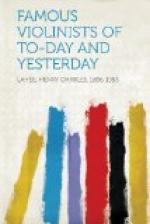From time to time this society gave subscription concerts, and Becker was invited to lead ten such concerts during the winter of 1865-66. He consented to do so, but found the quartet in a state of dissolution. He brought Hilpert with him, and engaged Masi as second violin, Chiostro being the only member of the original quartet. Masi was not accustomed to chamber music, but Becker took him in hand and he improved rapidly. In order to still enhance his value in the quartet, Becker presented him with a Stradivarius violin. They remained in Florence until their ensemble was absolutely perfect, and then began a series of tours which took them all over Europe. In Vienna the quartet was subjected to comparison with those of Hellmesberger and of Joachim, for the former had just given six chamber concerts, and the latter three. The first concert given by the Florentine Quartet was thinly attended, but the report of its excellence brought an overflowing audience to the second concert, and in all ten were given during the remainder of the season.
About 1875 Hilpert withdrew, and his place was filled by Hegyesi, who remained with the quartet until it was disbanded in 1880.
An excellent series of quartet concerts was founded in Stuttgart by Edmund Singer, who was appointed professor of violin in the Conservatorium, leader of the court music, and chamber musician, in 1861, after a distinguished career of some ten or more years as a virtuoso. These concerts met with triumphant success.
Georg J.R. Heckmann founded a quartet at Cologne and travelled through Europe, but it was surpassed by the Florentine Quartet, and did not gain the highest reputation.
A quartet which has been pronounced to be one of the best in existence is that which is led by Jeno Hubay, in Pesth, and in which Hegyesi, formerly of the Florentine Quartet, is the ’cellist.
Adolf Brodsky, who for a time resided in New York, founded a string quartet at Leipzig, with Hans Becker, son of the founder of the Florentine Quartet, Hans Sitt, and Julius Klengel, the ’cellist, and this quartet was said to have no superior in Europe, and not more than one equal,—the Joachim Quartet of Berlin. In 1891 Brodsky went to New York, where he also established a quartet, but with little success. The organisation was received with respect, owing to Mr. Brodsky’s European reputation, but it was admitted on all hands that superior organisations existed in America. Before Mr. Brodsky had time to bring his quartet to a high degree of proficiency, he returned to Europe, and, after a brief stay in Germany, accepted a position in England, where he has established another quartet.
He was succeeded in the quartet at Leipzig and at the conservatory by Arno Hilf, a distinguished violinist with an enormous technique, who was born in 1858 and was taught by David, Roentgen, and Schradieck.




